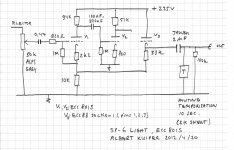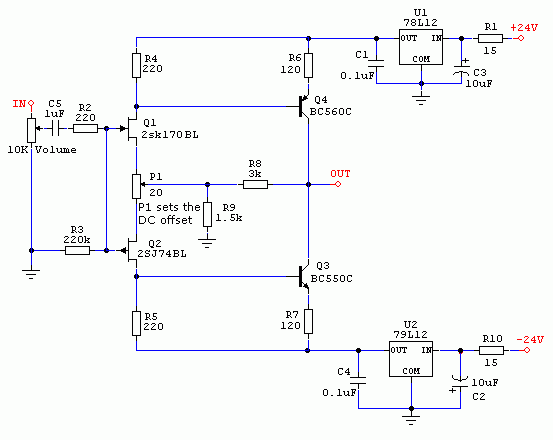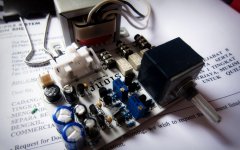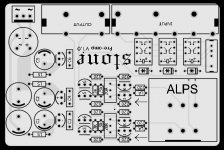Ide,
increase the output to ~10Vac. This is safely below the onset of (voltage) clipping of the signal.
Run the sim.
Add a 10k load (the next receiver stage Rin) in parallel to the 100k.
Run the sim.
Add 1000pF (cable and parasitics) in parallel to the 100k output load.
Run the sim.
You will find that 220r for R8 & R9 have strangled the amplifier. It current clips when you add on any sensible output load.
increase the output to ~10Vac. This is safely below the onset of (voltage) clipping of the signal.
Run the sim.
Add a 10k load (the next receiver stage Rin) in parallel to the 100k.
Run the sim.
Add 1000pF (cable and parasitics) in parallel to the 100k output load.
Run the sim.
You will find that 220r for R8 & R9 have strangled the amplifier. It current clips when you add on any sensible output load.
You don't need 10Vac to drive the F5 - 4V_peak at most.....increase the output to ~10Vac. ....
Nobody drives the home amp through 10m of extremely bad cable...Add 1000pF (cable and parasitics) ...
If you'd bothered to read the thread's title you'd see that it's about driving the F5 which happens to have Zin of 101k. This preamp is made to do just that and 101k is very sensible load in this situation...... It current clips when you add on any sensible output load.
The preamp's output stage is Source Follower and it will drive lower loads effortlessly (although it's aim is only to drive F5). Feedback network (R16/R3) will lower the preamp's Zout considerably.
Last edited:
This is not the appropriate topology for k170 - there are better ways to use them. The idea was to use the cheap and easily obtainable JFET like BF245c - not everyone can get genuine k170.has anyone tried using sk170?,
Juma, how does it sounds and what are component values?
thanks
This preamp sounds OK, but BF862 preamp (mentioned in post #154) is noticeably better.
Juma,
Anything stopping one from adding pot across input Jfet Rs for Pass THD trick or would this throw off the bias setting circuit due to the fact the bias network is tied to opposing rails and not ground
Anything stopping one from adding pot across input Jfet Rs for Pass THD trick or would this throw off the bias setting circuit due to the fact the bias network is tied to opposing rails and not ground
Juma,
what is your purpose?
On the one hand you categorise my suggestions for carrying out a revealing simulation as effectively worthless and on the other you tell us that the same schematic is "not the appropriate topology".
I suggested to Ide that he sims a more realistic load in stages so that he learns what questions he should ask the simulator so that he gets useful information on which he can build. If one only asks the simulator to give answers into a virtual perfect environment then the sim experience is going to teach Ide nothing.
I suggest that any simulator user should be trying to understand what the circuit does and how it reacts to different questions. Else they will never learn anything.
what is your purpose?
On the one hand you categorise my suggestions for carrying out a revealing simulation as effectively worthless and on the other you tell us that the same schematic is "not the appropriate topology".
I suggested to Ide that he sims a more realistic load in stages so that he learns what questions he should ask the simulator so that he gets useful information on which he can build. If one only asks the simulator to give answers into a virtual perfect environment then the sim experience is going to teach Ide nothing.
I suggest that any simulator user should be trying to understand what the circuit does and how it reacts to different questions. Else they will never learn anything.
Last edited:
Buzz, not much to be gained - different circuit, different JFETs...
Sorry juma, i mistakenly forgot to reference your F5 like pre with my question.
In that case, it's OK to play with Rs values. And JFETs' Sources are still AC grounded (through big caps).Sorry juma, i mistakenly forgot to reference your F5 like pre with my question.
Hi Juma & Andrew thanks for your replies, I like the sound of my (tube) Aikido and want to try the Fet version since I got 2 quad match sk170's. I did simulation on Juma's circ with BF245C, it runs fine, not so with sk170 🙁
Is using sk170 in aikido'ish fashion still possible?
Is using sk170 in aikido'ish fashion still possible?
Juma,
what is your purpose?.......
Attachments
Possible, but not usable as a line preamp (too much gain, too low Vgs)......Is using sk170 in aikido'ish fashion still possible?
In that case, it's OK to play with Rs values. And JFETs' Sources are still AC grounded (through big caps).
Thanks. Just making sure.
Possible, but not usable as a line preamp (too much gain, too low Vgs)...
I see, it's not worth pursuing then, thank you Juma
A tube preamp for the F5
With my F5 I wanted a preamp,
For some time I used an Aikido 6SN7 version, but I found it did not resolve well enough, it did not match the dynamic capabilities of the F5 and I heard some harshness maybe indicating slew rate limiting (choirs, violin sections). Even though the units measured well and did generally sound good on a 300B PP amp.
I made a clone of the well-known Audio Research SP-6, using ECC81 instead of ECC83. It took me quite some time to get all the details right, but the result now can be shared.
The result is more than satisfying. A big improvement in the bass section and I have very stable mid highs now. An other improvement is that the sound stage remains the same independent of the volume setting. Before I had only heard that once with the best digital volume control at Guido Tent. So yes, very, very happy.

The BW is 1- >300 kHz, Vout max is about 25 Volts RMS. So yes, it can be overdriven without a problem. Distortion less than 0,1%, second harmonic.
In the mean time I also made a 6SN7 version (that also tests excellent) but I have not listened to that yet.
View attachment Line Amp 6SN7.pdf
albert
With my F5 I wanted a preamp,
- with extreme dynamics
- cope with complex passages
- render the color and timbre of instruments
- display the depth of the recording space
- highlight the position and movement of singers
- solid bass that retains the image irrespective of the dynamics (punchline)
- depth and easy listening (no projection)
- something like 14-16 dB only
- no hum or artifices even at highest volume setting (it is flat open that I mostly use)
For some time I used an Aikido 6SN7 version, but I found it did not resolve well enough, it did not match the dynamic capabilities of the F5 and I heard some harshness maybe indicating slew rate limiting (choirs, violin sections). Even though the units measured well and did generally sound good on a 300B PP amp.
I made a clone of the well-known Audio Research SP-6, using ECC81 instead of ECC83. It took me quite some time to get all the details right, but the result now can be shared.
The result is more than satisfying. A big improvement in the bass section and I have very stable mid highs now. An other improvement is that the sound stage remains the same independent of the volume setting. Before I had only heard that once with the best digital volume control at Guido Tent. So yes, very, very happy.
- I do have a delay switch on the output that shorts the output after the coupling cap with 200 ohms for 10 seconds. The DC over my speaker is maximum 2,5 V DC in this period.

The BW is 1- >300 kHz, Vout max is about 25 Volts RMS. So yes, it can be overdriven without a problem. Distortion less than 0,1%, second harmonic.
In the mean time I also made a 6SN7 version (that also tests excellent) but I have not listened to that yet.
View attachment Line Amp 6SN7.pdf
albert
Thanks. I am using the schematic from post 53rd. 🙂

Subjectively, it's giving me sparkling high than never before! 😱
...very nice one! parts ordered yesterday, can't wait to build it! 😀
I found some differences in your PCB and the Layout: The C numbers are not the same. (in the PCB C3 is a small one, in the layout it's a big one with polarity)
Is the layout correct? It would be no problem then, I will do it on a experimental-PCB.
And is it ok to use 12V-R-core transformers? That would give me about 16V DC, should be enough for the 78/7912, correct?
Regards,
Matthias 😉
Last edited:
- Home
- Amplifiers
- Pass Labs
- Preamp ideas for F5


